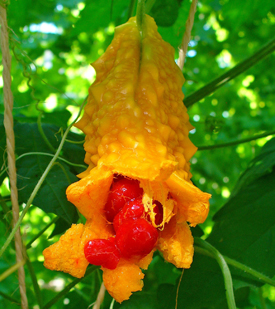
The FA conjugase from Momordica charantia converts linoleate (18:2, 9cis 12cis) to the conjugated FA (CFA), 18:3, 9-cis, 11-trans, 13-trans (eleostearate). Conjugated fatty acids are used as drying oils and can serve as replacements to petroleum additives to reduce VOC emissions from paints and other coating materials.
α-Eleostearic acid (octadeca-cis-9, trans-11, trans-13-trienoic acid, 18:3Δ9cis, 11trans, 13trans) is one of at least seven types of conjugated fatty acids that can occur in seed oils of plants. The double bonds of conjugated fatty acids are arranged at adjacent carbon atoms rather than separated by a methylene group (-CH2-) as is the case in linoleic and α-linolenic acids, the typical polyunsaturated fatty acids of seed oils. The conjugated unsaturation makes these fatty acids more prone to oxidation. This is a desired property of vegetable oils that are used as solvents in inks, paints, and varnishes, as the polymerization associated with oxidation of the double bonds results in faster drying rates. The occurrence of conjugated fatty acids in seed oils is limited to a small number of species representing at least eight plant families. The primary commercial source of α-eleostearic acid-rich drying oils is seeds from the tung tree (Vernicia fordii). α-Eleostearic acid composes >80% of the fatty acids of tung oil. Cultivation of tung is retricted to subtropical climates, and the supply of tung seeds often varies widely from year-to-year. In addition, like many other Euphorbiaceae, tung seeds contain toxins. Other potential sources of α-eleostearic acid-enriched oils include seeds of the Cucurbitaceae Momordica charantia (bitter melon), which is one of the target species of our research. α-Eleostearic acid composes ~65% of the fatty acids of bitter melon seed oil. Although bitter melon is grown as a vegetable, its viny growth morphology and low production of seeds limit its potential as an oilseed crop. Given the lack of a suitable temperate source of α-eleostearic acid for drying oil applications, it is desirable to engineer an existing oilseed crop to produce high levels of this fatty acid.
The conjugated double bonds of α-eleostearic acid are produced by a variant form of the Δ12-oleic acid desaturase (FAD2) termed a "fatty acid conjugase". The fatty acid conjugase from plants such as bitter melon converts the cis-Δ12 double bond of linoleic acid bound to phosphatidylcholine (PC) into trans-Δ11 and trans-Δ13 double bonds. This reaction results in Δ11 and Δ13 double bonds that are in a conjugated configuration with the cis-Δ9 double bond. The bitter melon fatty acid conjugase has been expressed in seeds of Arabidopsis and in seeds and somatic embryos of soybean to produce eleostearic acid to levels of nearly 20% of the total seed oil. Seeds from these plants, however, typically have a wrinkled morphology and strongly impaired germination. In addition, α-eleostearic acid not only accumulates in the storage triacylglycerols of the engineered seeds, but is also present in elevated levels in PC and other membrane phospholipids. By contrast, seeds from plants that naturally produce conjugated fatty acids (e.g., bitter melon) have apparently evolved enzyme(s) that efficiently remove these fatty acids from PC and other phospholipids and prevent their accumulation in membranes. To uncover mechanisms specialized for eleostearic acid metabolism, deep sequencing of expressed genes in developing bitter melon seeds will be conducted. Genetic screens will also be undertaken to identify bitter melon genes that rescue the wrinkled seed phenotype of Arabidopsis seeds engineered to produce α-eleostearic acid. It is expected that genes identified in these studies will facilitate the production of conjugated fatty acids at high levels, with minimal agronomic impact, in seeds of established oilseed crops.
